Family Aizoaceae Tribe Ruschiae Higher classification Ruschioideae | Subfamily Ruschioideae Scientific name Lithops Rank Genus | |
 | ||
Lower classifications Lithops pseudotruncatella, Lithops karasmontana | ||
Lithops is a genus of succulent plants in the ice plant family, Aizoaceae. Members of the genus are native to southern Africa. The name is derived from the Ancient Greek words λίθος (lithos), meaning "stone," and ὄψ (ops), meaning "face," referring to the stone-like appearance of the plants. They avoid being eaten by blending in with surrounding rocks and are often known as pebble plants or living stones. The formation of the name from the Greek "-ops" means that even a single plant is called a Lithops.
Contents
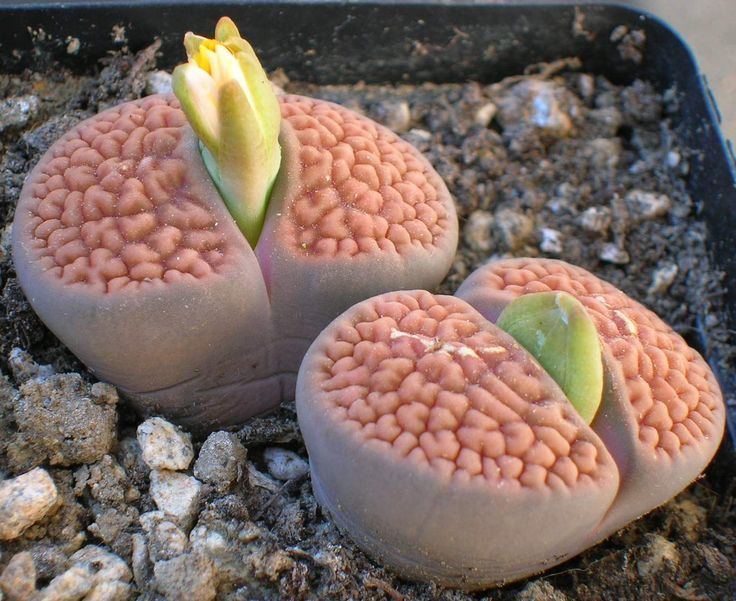
Planting lithops seeds
Description
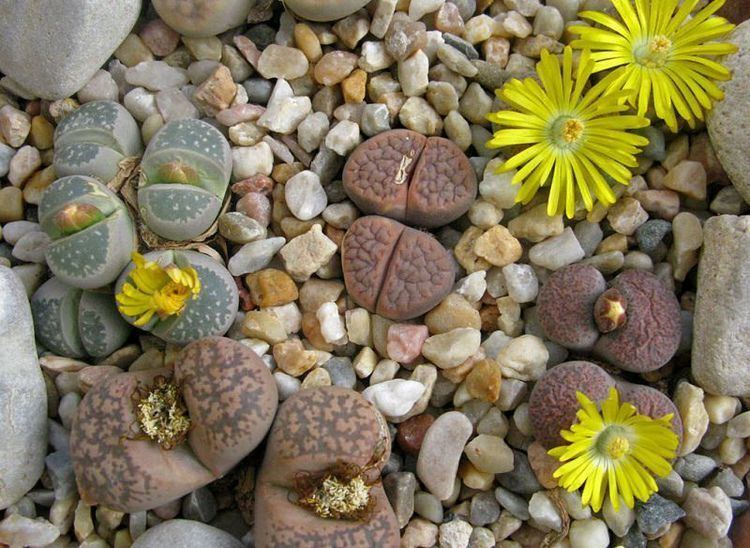
Individual Lithops plants consist of one or more pairs of bulbous, almost fused leaves opposite to each other and hardly any stem. The slit between the leaves contains the meristem and produces flowers and new leaves. The leaves of Lithops are mostly buried below the surface of the soil, with a partially or completely translucent top surface known as a leaf window which allows light to enter the interior of the leaves for photosynthesis.
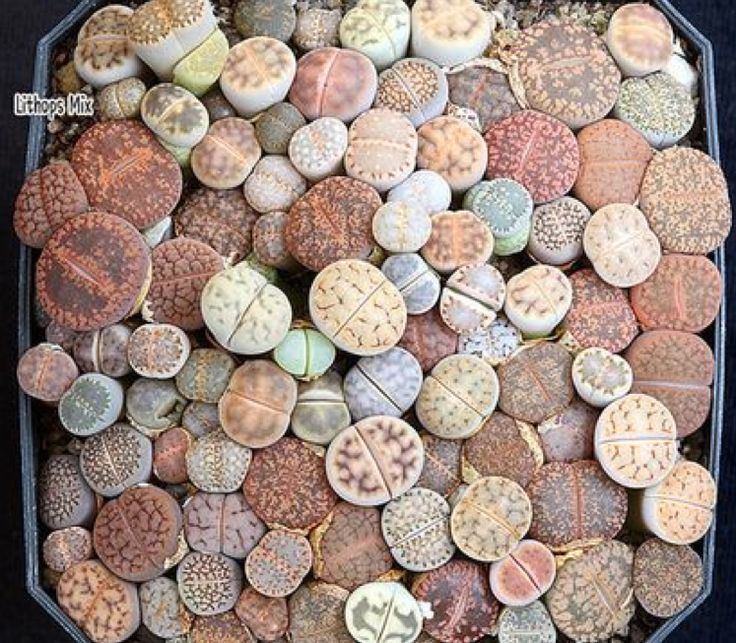
During winter a new leaf pair, or occasionally more than one, grows inside the existing fused leaf pair. In spring the old leaf pair parts to reveal the new leaves and the old leaves will then dry up. Lithops leaves may shrink and disappear below ground level during drought. Lithops in habitat almost never have more than one leaf pair per head, presumably as an adaptation to the arid environment. Yellow or white flowers emerge from the fissure between the leaves after the new leaf pair has fully matured, one per leaf pair. This is usually in autumn, but can be before the summer solstice in L. pseudotruncatella and after the winter solstice in L. optica. The flowers are often sweetly scented.
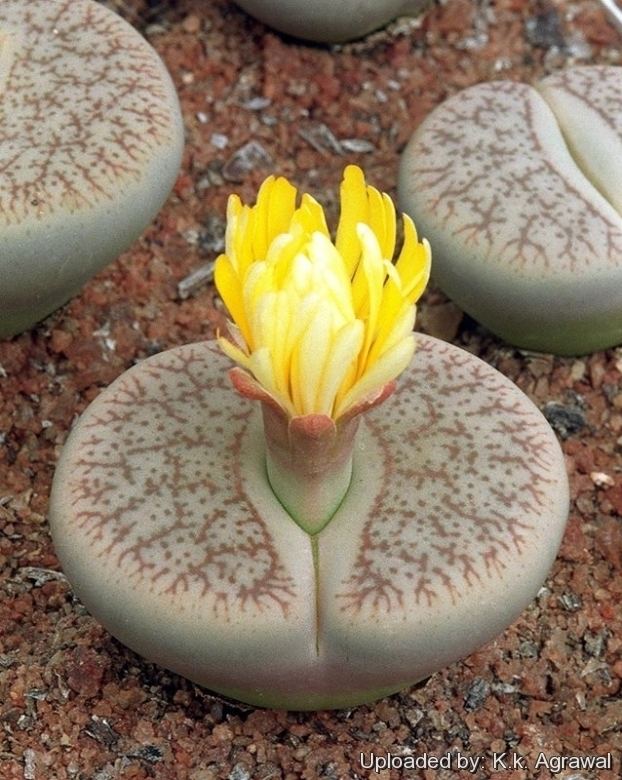
The most startling adaptation of Lithops is the colouring of the leaves. The leaves are fenestrated, and the epidermal windows are patterned in various shades of cream, grey, and brown, with darker windowed areas, dots, and red lines, according to species and local conditions. The markings function as remarkable camouflage for the plant in its typical stone-like environment. As is typical of a window plant, the green tissue lines the inside of the leaves and is covered with translucent tissue beneath the epidermal windows.
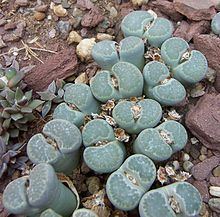
Lithops are obligate outcrossers and require pollination from a separate plant. Like most mesembs, Lithops fruit is a dry capsule that opens when it becomes wet; some seeds may be ejected by falling raindrops, and the capsule re-closes when it dries out. Capsules may also sometimes detach and be distributed intact, or may disintegrate after several years.
Distribution
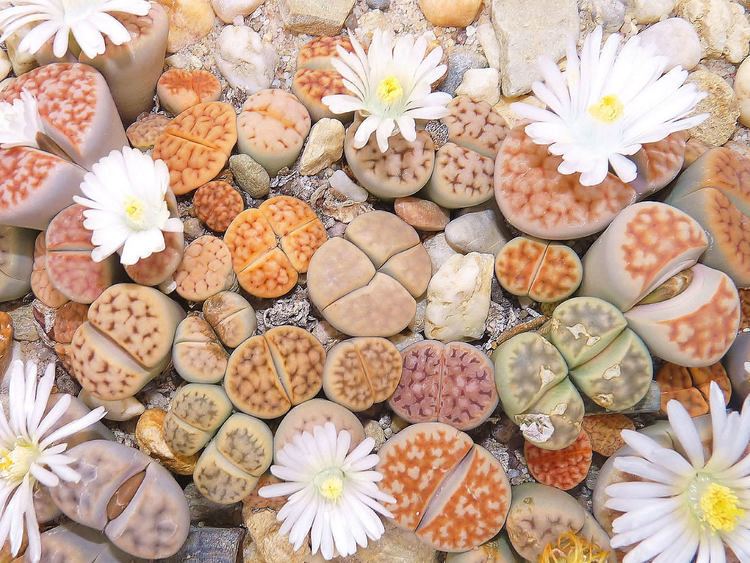
Lithops occur naturally across wide areas of Namibia and South Africa, as well as small bordering areas in Botswana and possibly Angola, from sea level to high mountains. Nearly a thousand individual populations are documented, each covering just a small area of dry grassland, veld, or bare rocky ground. Different Lithops species are preferentially found in particular environments, usually restricted to a particular type of rock. Lithops have not naturalised outside this region.
Rainfall in Lithops habitats ranges from approximately 700 mm/year to near zero. Rainfall patterns range from exclusively summer rain to exclusively winter rain, with a few species relying almost entirely on dew formation for moisture. Temperatures are usually hot in summer and cool to cold in winter, but one species is found right at the coast with very moderate temperatures year round.
Cultivation
Lithops are popular novelty house plants and many specialist succulent growers maintain collections. Seeds and plants are widely available in shops and over the Internet. They are relatively easy to grow if given sufficient sun and a suitable well-drained soil.
Normal treatment in mild temperate climates is to keep them completely dry during winter, watering only when the old leaves have dried up and been replaced by a new leaf pair. Watering continues through autumn when the plants flower and then stopped for winter. The best results are obtained with additional heat such as a greenhouse. In hotter climates Lithops will have a summer dormancy when they should be kept mostly dry, and they may require some water in winter. In tropical climates, Lithops can be grown primarily in winter with a long summer dormancy. In all conditions, Lithops will be most active and need most water during autumn and each species will flower at approximately the same time.
Lithops thrive best in a coarse, well-drained substrate. Any soil that retains too much water will cause the plants to burst their skins as they over-expand. Plants grown in strong light will develop hard strongly coloured skins which are resistant to damage and rot, although persistent overwatering will still be fatal. Excessive heat will kill potted plants as they cannot cool themselves by transpiration and rely on staying buried in cool soil below the surface.
Propagation of Lithops is by seed or cuttings. Cuttings can only be used to produce new plants after a plant has naturally divided to form multiple heads, so most propagation is by seed. Lithops can readily be pollinated by hand if two separate clones of a species flower at the same time, and seed will be ripe about 9 months later. Seed is easy to germinate, but the seedlings are small and vulnerable for the first year or two, and will not flower until at least two or three years old.
History
The first scientific description of a Lithops was made by botanist and artist William John Burchell, explorer of South Africa, although he called it Mesembryanthemum turbiniforme. In 1811 he accidentally found a specimen when picking up from the ground a "curiously shaped pebble". Unfortunately his description is not detailed enough to be sure which Lithops he had discovered and the name Lithops turbiniformis is no longer used, although for many years it was applied to what is now known as Lithops hookeri.
Several more Lithops were published as Mesembryanthemum species until in 1922 N E Brown started to split up the overly large genus on the basis of the capsules. The genus Lithops was created and dozens more species were published in the following decades. Brown, Gustav Schwantes, Kurt Dinter, Gert Nel, and Louisa Bolus continued to document Lithops from across southern Africa, but there was little consensus on the relationships between them, or even which populations should be grouped as species. As recently as the 1950s, the genus was little known in cultivation and not well understood taxonomically.
In the 1950s, Desmond and Naureen Cole began to study Lithops. They eventually visited nearly all habitat populations and collected samples from approximately 400, identifying them with the Cole numbers which have been used ever since and distributing Cole numbered seed around the world. They studied and revised the genus, in 1988 publishing a definitive book (Lithops: Flowering Stones) describing the species, subspecies, and varieties which have been accepted ever since.
Because their camouflage is so effective, new species continue to be discovered, sometimes in remote regions of Namibia and South Africa, and sometimes in well-populated areas where they simply had been overlooked for generations. Recent discoveries include L. coleorum in 1994, L. hermetica in 2000, and L. amicorum in 2006.
Taxonomy
Many of the species listed have named subspecies or varieties and some have many regional forms identified by old names or habitat locations. Identification of species is primarily by flower colour and leaf patterns.
